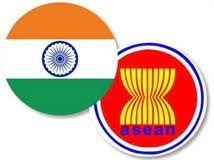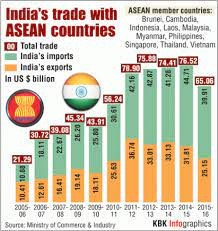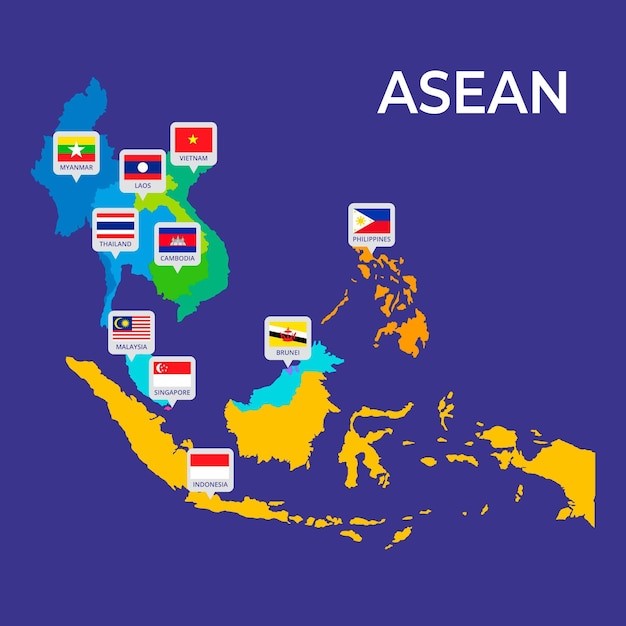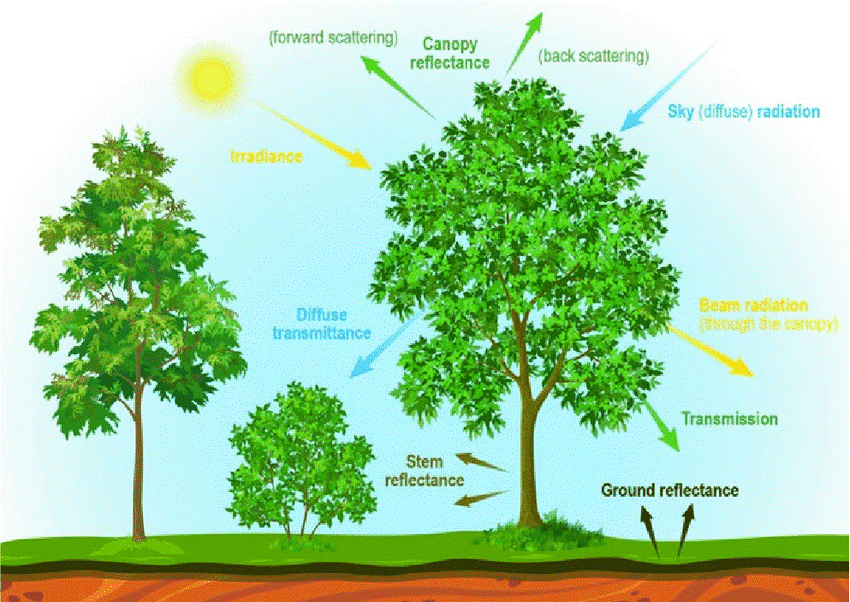Topics:
- Yasuni National Park
- ASEAN – India Fta
- Government e-Marketplace
- Acoustic Cryptanalysis
- Vegenated Canopies
Yasuni National Park
Context
- In a historic moment, the people of Ecuador have chosen to safeguard their natural heritage by rejecting plans for oil drilling in Yasuni National Park through a significant referendum.
Exploring Yasuni National Park
- Yasuni National Park, bestowed with the prestigious UNESCO biosphere reserve status in 1989, spans an expansive million hectares, offering refuge to an extraordinary array of biodiversity.
- Nestled within the Amazon rainforest – renowned as a global epicenter for species variety – the park finds its home in Ecuador’s northeastern region, encompassing parts of the Napo and Pastaza provinces.
- The vast expanse of the park blankets an impressive 9,820 square kilometers (3,791 square miles).
A Marvel of Diversity
- Yasuni stands as an unparalleled testament to biological diversity. With an estimated 670 avian species, over 150 amphibian species, and a multitude of remarkable large mammals such as jaguars, pumas, and tapirs, the park showcases an intricate web of life found within its borders.
Cultural Resonance with Indigenous Communities
- Beyond its ecological significance, Yasuni is the cherished abode of several indigenous communities, most notably the Waorani and Kichwa peoples.
- These communities have nurtured an enduring bond with the land for generations, embodying a profound interconnection with the environment.
By making the conscious choice to reject oil drilling in Yasuni National Park, Ecuadorians have not only preserved a remarkable treasure trove of biodiversity but have also honored the cultural heritage and ancestral ties of the indigenous communities that call this land home.
ASEAN - INDIA FTA
Context:
- India and the Association of Southeast Asian Nations (ASEAN) have come to an agreement to reevaluate their trade pact by the year 2025.
- This decision follows less than a month after India’s trade minister criticized the agreement, citing its inequitable impact on the Indian industry.
Outcome of Economic Ministers Meeting in Indonesia:
The decision to review the trade pact was reached during a meeting of economic ministers from India and ASEAN held in Indonesia.
ASEAN-India Trade in Goods Agreement (AITIGA):
The ASEAN-India Trade in Goods Agreement, commonly referred to as AITIGA, was officially signed in 2009.
ASEAN–India Free Trade Area (AIFTA):
The ASEAN–India Free Trade Area (AIFTA) serves as a collaborative initiative, fostering a free trade area between India and the ten member states of ASEAN.
- The implementation of AIFTA commenced in January 2010.
This agreement established a structured timeline for the gradual elimination of tariffs on a wide range of traded goods between the two regions.
- The creation of the ASEAN-India Free Trade Area was driven by the shared interest of both parties in expanding economic ties within the Asia-Pacific region.
- India’s Look East policy was met with reciprocal enthusiasm from multiple ASEAN nations, each aiming to enhance their interactions and economic connections toward the western direction.
ASEAN Basics
- ASEAN, or the Association of Southeast Asian Nations, is a regional organization of 10 Southeast Asian and Pacific Rim countries whose governments collaborate to promote socio-cultural, economic, and political advancement in the region.
- The motto of ASEAN is “One Vision, One Identity, One Community”.
- ASEAN was established in 1967 with the signing of the Bangkok Declaration by its founding members: Indonesia, Malaysia, Philippines, Singapore, and Thailand.
Since then, ASEAN has expanded its membership to include Brunei, Vietnam, Laos, Myanmar, and Cambodia.
Objectives and Principles
- The main objectives of ASEAN are to accelerate economic growth, social progress and cultural development for a prosperous and peaceful community of Southeast Asian Nations.
- To promote regional peace and stability through abiding respect for justice and the rule of law and adherence to the principles of the United Nations Charter.
- To promote active collaboration and mutual assistance on matters of common interest in the economic, social, cultural, technical, scientific and administrative fields.
- The fundamental principles of ASEAN are based on the Treaty of Amity and Cooperation in Southeast Asia (TAC) of 1976, which include mutual respect for the independence, sovereignty, equality, territorial integrity, and national identity of all nations
- non-interference in the internal affairs of one another
- settlement of differences or disputes by peaceful means
- renunciation of the threat or use of force; and effective cooperation among themselves.
Community and Cooperation
- In 2003, ASEAN agreed to establish an ASEAN Community that consists of three pillars
- the ASEAN Political-Security Community (APSC),
- the ASEAN Economic Community (AEC), and
- the ASEAN Socio-Cultural Community (ASCC).
- The APSC aims to ensure that countries in the region live at peace with one another and with the world in a just, democratic and harmonious environment.
- The AEC aims to create a single market and production base that is highly competitive, equitable in development and fully integrated into the global economy.
- The ASCC aims to nurture a caring and sharing society that is inclusive and harmonious.
- In 2015, ASEAN launched the ASEAN Community Vision 2025, which provides a roadmap for the next decade of integration and cooperation among the member states.
How does ASEAN-India cooperation benefit India?
ASEAN-India cooperation benefits India in various ways, such as:
- It enhances India’s economic growth and integration with the region, as ASEAN is India’s fourth-largest trading partner and a major source of investment, tourism, and remittances.
- It strengthens India’s strategic and security interests in the Indo-Pacific, as ASEAN is a key partner in promoting a free, open, inclusive, transparent, rules-based, peaceful, and prosperous region.
- India and ASEAN cooperate on issues such as counter-terrorism, maritime security, cyber security, transnational crime, disaster management, defence dialogue, etc. through various mechanisms such as the East Asia Summit (EAS), the ASEAN Regional Forum (ARF), the ASEAN Defence Ministers’ Meeting Plus (ADMM+), etc.
- It fosters India’s cultural and people-to-people ties with the region, as ASEAN and India share a long history of civilizational links and cultural exchanges.
- India and ASEAN cooperate on education, culture, tourism, media, youth, women, health, environment, etc. through various initiatives such as the ASEAN-India Network of Universities (AINU), the ASEAN Cultural Heritage List, the ASEAN-India Hackathon, the Ramayana Festival, the Film Festival, etc.
Therefore , ASEAN-India cooperation is a win-win situation for both sides that enhances their mutual trust , understanding , and partnership .
Government e-Marketplace
Context
- In a groundbreaking leap forward, the central public sector enterprises (CPSEs) have arranged an extraordinary 74% surge in procurement, totaling a whopping Rs 42,510 crore, within the initial four months of the 2023-24 period, effectively outpacing the corresponding term in the previous year.
Unveiling the Government e-Marketplace (GeM)
- The curtain rises on the Government e-Marketplace (GeM), an avant-garde virtual realm that has redefined the very essence of procurement.
- Rising from the ashes of the Directorate General of Supplies and Disposals (DGS&D) in 2016, GeM emerges as an innovative, contactless, paperless, and cashless haven.
Genesis and Ascent
- Bearing the torch of progress, GeM made its luminous debut on August 9, 2016, under the aegis of the Ministry of Commerce and Industry, Government of India.
- Its mission: to erect an unblemished stage for procurement, one defined by transparency and inclusivity.
- This audacious initiative came to life in a record-setting five months, breathing life into online procurement for an array of goods and services.
Pioneering a Paradigm Shift
- A seminal moment arrived with the General Financial Rules of 2017, where the Ministry of Finance penned a new directive into existence.
- This mandate, etched into the annals of the General Financial Rules, bestowed the government users with the authority and obligation to procure through GeM.
The Architect and Sentinel
- GeM stands as the brainchild of the GeM SPV (Special Purpose Vehicle), an entity fully enshrined within the domain of the Ministry of Commerce and Industry, Government of India.
- A harbinger of change, the Government now compels sellers to unveil the origin of their wares on the GeM platform, embodying a spirit of transparency.
Unveiling the Keynotes
- GeM isn’t just a portal; it’s a revelation, offering an all-encompassing gateway to usher in a new era of online procurement for ubiquitous goods and services.
- The expanse of its embrace includes the entirety of the government echelon—Central and State Ministries, departments, and public sector enterprises all find solace within its virtual confines.
- While private buyers are barred from this sacred enclave, private enterprises find themselves armed with the ability to bestow their products upon governmental bodies through the portal.
The Radiance of Significance
- Inscribing its name in the annals of progress, GeM unfurls a tapestry woven with the threads of transparency, cost-effectiveness, and a clarion call for self-reliance.
- As the wheels of its operation turn, the symphony of Atma Nirbhar Bharat resonates, and the welcome mat is rolled out for small-scale local merchants to join the grand stage of government procurement.
Basics of GEM
Government e-Marketplace (GeM) is the National Public Procurement Portal; an end-to-end online Marketplace for Central and State Government Ministries / Departments, Central & State Public Sector Undertakings, Autonomous institutions and Local bodies, for procurement of common use goods & services. GeM is owned and managed by GeM SPV which is a Section 8 (Non-Profit) Company registered under the Companies Act, 2013.
GeM aims to enhance transparency, efficiency and speed in public procurement.
It provides the tools of e-bidding, reverse e-auction and demand aggregation to facilitate the government users achieve the best value for their money.
GeM also offers a number of benefits to the buyers and sellers, such as:
- Rich listing of products and services across diverse categories
- Integrated payment system with multiple payment options
- Multiple procurement modes – Direct Purchase / Bid / RA
- Online ordering and contract generation
- Online user rating and feedback system
- Dynamic pricing and product comparison
- Quality assurance through GeM Quality Certification Services
- Dedicated GeM Customer Care Support.
GeM also provides a learning management system (LMS) for training and coaching of buyers and sellers.
GeM LMS features videos, guides, resources, webinars, social media feeds and FAQs to help users master the usage of GeM portal.
GeM LMS is open for all and free of cost.
ACOUSTIC CRYPTANALYSIS
Introduction: The Power of Acoustic Cryptanalysis
- A recent study titled “A Practical Deep Learning-Based Acoustic Side Channel Attack on Keyboards” has revealed the potential of Artificial Intelligence (AI) in decoding passwords through the analysis of keystroke sounds.
- Acoustic cryptanalysis, a form of side channel attack, exploits the sounds emitted by devices like computers to uncover sensitive information.
- This method primarily targets the distinctive sounds generated by computer keyboards and internal components.
Historical Perspective: Acoustic Cryptanalysis Evolution
- Acoustic cryptanalysis is not a new concept. Its historical use can be traced back to impact printers and electromechanical deciphering machines.
- This technique, which originally focused on these devices, has now evolved to exploit the sounds produced by modern computer keyboards.
Technique Exploitation: Analyzing Keyboard Sounds
- The core of this approach lies in utilizing the unique sounds created while typing on a keyboard to deduce the keys being pressed.
- By carefully analyzing these distinct sounds, hackers can decode specific letters and numbers, effectively revealing the entered password.
ASCA Attacks: Leveraging Diverse Audio Sources
- Researchers conducting the study adopted a multifaceted approach by incorporating audio recordings from various sources such as Zoom calls, smartphone microphones, and common equipment.
- These recordings were utilized in conjunction with algorithms for ASCA (Acoustic Side Channel Attack) attacks.
- The study aimed to evaluate the effectiveness of the method across different audio sources.
Nearby Phone Training: Achieving Remarkable Accuracy
- An intriguing finding of the study was that training the AI classifier with keystrokes from a nearby phone led to an impressive accuracy rate of 95%.
- Remarkably, this high level of accuracy was attained without the need for a language model, signifying a significant achievement in this realm of research.
Deep Learning Triumph: Unveiling Accurate Interpretation
- By employing a deep learning model with default settings, the researchers were able to effectively interpret the collected data.
- Notably, this model achieved remarkable accuracy even with minimal training data when tested on a MacBook Pro featuring a keyboard design similar to recent Apple models.
Smartphone Microphone Recognition: Impressive Results
- The AI model’s adaptability was showcased when it was trained to recognize keystrokes through audio recorded via smartphone microphones.
- This adaptation yielded an impressive accuracy rate of 95%, further underscoring the potential of this technique.
Implications: Data Security and Privacy Risks
- The study’s findings underscore the significant implications of this hacking method.
- By exploiting the sounds of keystrokes, sensitive information such as passwords and personal messages can be exposed.
- Consequently, this technique poses substantial risks to both data security and user privacy.
Understanding Side Channel Attacks (SCAs)
Defining Side-Channel Attacks
Side-channel attacks are security exploits that bypass targeting a program directly and instead gather information from a system’s hardware through indirect effects.
These attacks leverage unintended hardware emissions to access sensitive data, including cryptographic keys.
Types of Side Channel Attacks SCAs
- Electromagnetic Attacks
– Attackers measure electromagnetic radiation emitted by a device to reconstruct internal signals.
– Historical attacks like van Eck phreaking were based on electromagnetic methods.
– Modern attacks focus on measuring cryptographic operations to derive secret keys.
– Software-defined radio (SDR) devices enable electromagnetic attacks, even through walls.
- Acoustic Attacks
- Attackers capture sounds produced by a device.
- Proof-of-concept attacks demonstrate the reconstruction of keystrokes from audio recordings.
- Electronic component sounds can be exploited by hackers to gather information.
Conclusion: Unveiling Vulnerabilities and Ensuring Security
The study’s demonstration of AI-powered acoustic cryptanalysis highlights the vulnerabilities inherent in modern computing systems.
By exploring the realm of side-channel attacks, it becomes apparent that ensuring data security and user privacy requires a multifaceted approach that goes beyond traditional software-based defenses.
It is imperative to address potential hardware-related vulnerabilities to safeguard sensitive information effectively.
VEGENATED CANOPIES
Introduction: Enhancing Urban Greenery through Vegetated Canopies
- In Spain, a unique initiative has emerged to reintroduce lush greenery to urban environments.
- This initiative involves the installation of innovative vegetated awnings or canopies, which not only add aesthetic value but also contribute to environmental sustainability.
Exploring the Concept of Vegetated Canopies
- Vegetated canopies, known as “Greenshades,” are sail-like structures designed to infuse urban spaces with the vibrancy of nature.
- These structures are skillfully attached to the facades of surrounding buildings, offering a fresh perspective on urban landscaping.
Mimicking Nature: Design and Installation
- These tensioned sail-like structures imitate the natural canopies found in lush forests, replicating the presence of various plant species.
- Unlike traditional urban spaces that often lack greenery, Greenshades are remarkably light and easy to install.
- This allows for the introduction of shade and green elements in commercial streets and public areas.
Mechanics of Greenshades: How They Operate
The process of creating Greenshades involves meticulous steps to ensure optimal plant growth and sustainability:
- Structural Preparation: The sail-like structures are equipped with anchors and supports, which are carefully integrated into the design of the surrounding buildings.
- Substrate Installation: A specialized geotextile substrate or material forms the foundation. This substrate is crucial for plant growth and nourishment.
- Irrigation System: An innovative irrigation system is incorporated at the highest point of the canopy. Water is distributed through gravity, saturating the entire substrate.
- Fertilization: Fertilizer is applied to maintain the vegetation’s health, ensuring lush and vibrant growth.
- Water Management: Excess water is collected and channeled through a drainage system, preventing waterlogging and promoting a balanced ecosystem.
- Planting Process: A mixture of seeds is projected onto the geotextile. Within approximately four months, the entire canopy is expected to be covered in lush vegetation.
- Hydroponic Growth: Plants thrive in a hydroponic environment, with designated water supply and drainage points.
Benefits of Greenshades: A Multi-Faceted Approach
The implementation of Greenshades offers numerous advantages, contributing to the betterment of urban spaces:
- Temperature Regulation: Evapotranspiration, the process of water transfer to the atmosphere through plants, helps regulate temperatures both within the canopy and its immediate surroundings.
- Air Purification: The chosen plant species excel in absorbing harmful gases like carbon monoxide and nitrogen oxide, enhancing air quality.
- Noise Reduction: The substrate’s sound-absorbing properties minimize noise pollution, creating a more serene urban environment.
- Oxygen Generation: A single square meter of vegetated canopy produces a year’s worth of oxygen for a person, while also acting as a filter for noxious gases.
- Efficient Lighting: Centralized water and light installations optimize resource utilization. Motion-sensor-equipped lights adjust illumination according to needs, promoting energy savings.
- Ecosystem Enrichment: Adoption of Greenshades can foster urban biodiversity, nurturing a healthier ecosystem that supports diverse wildlife.
Conclusion: A Greener Future for Urban Landscapes
The innovative concept of vegetated canopies, exemplified by Greenshades, presents a promising solution to the challenges of urbanization and environmental degradation.
By blending nature seamlessly into urban architecture, Spain’s initiative paves the way for more sustainable and vibrant cities.








